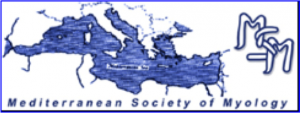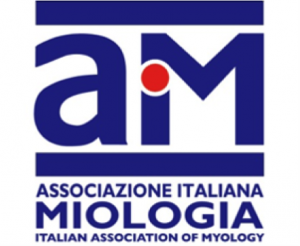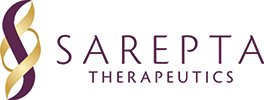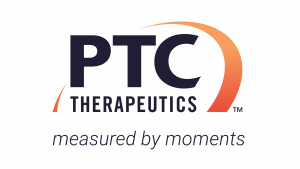AIM
The 18th Congress of the Italian Association of Myology was held from the 6 to 9 June in Genova, the same location that hosted the first meeting in 2000, organised by the same person, Professor Carlo Minetti.
Nearly 400 people from both Italy and all over the world attended this meeting, that with its 70 speakers, over 200 contributions and, for the first time, a joined session with the French Association of Myology, was one of the most intense and valuable of the past editions.
The congress was anticipated by a one-day full teaching course on the diagnostic interpretation of muscle biopsy. Several experts from Italy and Europe such as Maurizio Moggio, Enrico Bertini, Marina Mora, Rita Barresi and Edoardo Malfatti intervened and shared their expertise with the audience of young myologists.
For the first time the Congress had a topic: From Basic Muscle Science To Translational Myology. In the workshop dedicated to the basic muscle science, Professor Musarò from Rome introduced some of the common patho-mechanisms causing muscular dystrophy and damage of muscle fibres; Doctor Messina from Milan, explained the role of the transcription factor Nfix in the pathogenesis of Muscle Diseases; Professor Sandri, who worked for years in Basel, showed the molecular pathways involved in correct and altered muscle contraction; and Doctor Tedesco, a young Italian researcher working in London, fascinated the audience with the potentiality of 3D artificial skeletal muscle derived from pluripotent stem cells.
In the session of Experimental Therapy, Professor Malerba from London reported the results of a research on the genetic therapy for OPMD; Professor Desaphy explained the importance of the genetic background of congenital myotonia on the response to drug treatment; Doctor Gazzerro, another Italian scientist from Genova currently working in Berlin, argued on the double face of the inflammatory system in the pathogenesis of muscular dystrophy, potentially acting as both protective and aggravating element; finally Professor Corti from Milan reported on her work on induced pluripotent stem cells for the treatment of Spinal Muscular Atrophies.
The therapy of SMA was further discussed in a dedicated symposium. Results of the new genetic therapy able to rescue the production of SMN2, the vicariant gene of SMN complex, were reported. Italy was not less, treating so far 120 SMA1 children with astonishing results.
A further topic was the Diagnosis and Management of the Floppy Infant, a common diagnostic challenge and typical onset of many different neuromuscular conditions starting in the paediatric age. Beside these exciting topics, many other were discussed including 2 breakfast seminars, one on nutrition aspects in muscle diseases coordinated by Doctor Pini from Bologna, and the other one on the new molecular genetic technologies, wich saw Professor Tupler from Modena and Professor Vincenzo Nigro from Naples as speakers. To stay updated, early coffee for the Italian Myologists!
Four intense Lectures by national/international speakers enriched the congress. The opening one – in honour of the beloved Professor Giovanni Nigro who passes away in October 2017 – was made by Professor Politano, his pupil, who reinforced the role of Professor Nigro and the Italian school of Cardiomyology to build up the story of myology in Italy, and recalled how may muscle diseases can present with underlying heart conditions. Professor Di Mauro, a leading scientist at the Columbia University, who taught all mitochondrial secrets to many Italian Doctors, introduced the Mito-Lectures made by two eminent scientists, Professor Hirano and Professor Zeviani. The fourth lecture was held by Jeffrey Chamberlain from Washington, who has recently shown, in a Nature Communications paper, how CRISPR/Cas9 repertoire is able to restore dystrophin levels and improve muscle function in mice.
The novelty of the 18th AIM congress was undoubtedly the Joined Session with the colleagues from the French Association of Myology. Three French experts: Guillame Bassez, Pascale Laforet and Catherine Caraoult discussed with the Italian counterpart respectively on Myotonic Dystrophy, Pompe Disease and Laminopathies.
One-hundred-eighty posters and 32 oral presentations completed the congress program.
As it is tradition for many years, 2 prizes were awarded to young researchers for their innovative results, to Doctor Panicucci from the Genova University for his study on the antagonism of purinergic receptors to ameliorate muscle damage in mdx mice, and to Doctor Costa from the Bologna University for his study on the role of TNOP3 protein in myoblast myogenesis.
A third prize for the best oral communication, established by the Gaetano Torre Association for Muscular Diseases of Naples to honor the memory of Prof. Giovanni Nigro, was awarded to Dr. E. Malfatti for his studies on morphological features in patients with GYG1 mutations.
Finally, the social dinner inside the Aquarium of Genova, shocked the participants with a superb meal just between dolphins and turtles tanks. The next AIM congress will be held in Bergamo in June 2019. All the readers all welcome.
Congress report by Chiara Fiorillo, UOC Neurologia Pediatrica e Malattie Muscolari – Genova
MSM
The 13th Meeting of the Mediterranean Society of Myology (MSM) in connection with the 2nd Congress of the Neuromuscular Society of Turkey was held in Avanos, Cappadocia between 28-30 June. This was a special congress in honour of our late Professor Giovanni Nigro who was the founder of the MSM. He quoted in 2017 “thirty-six years ago, a group of researchers with interest in the field of muscular dystrophies felt the need to promote a mutual cooperation among the people of the Mediterranean area, and created the Mediterranean Society of Myology in 1993, in Ischia”.
The main theme of the congress was limb-girdle muscular dystrophies. A basic course on neuromuscular disorders in general was offered to the young scientists prior to the original conference. The whole area was covered by 38 invited speakers from basic science to bed-side along with future expectations, planning and thoughts, particularly newer therapies. There were over 200 participants to include the local members. A total of 38 bursaries were given (whom 15 were medical students). The conference was well-attended by scientists coming from 13 countries, not only the Mediterranean but also from Asia and the US.
Congress report by Haluk Topaloglu, Hacettepe Children’s Hospital 06100 Ankara, Turkey
WMS
The 23rd International WMS Congress will be held in Mendoza, Argentina from 2 to 6 October 2018. The symposium will follow the traditional format with 3 selected topics: new developments in genetic and acquired disorders of the neuromuscular junction; mitochondrial function and dysfunction in neuromuscular disorders: pathogenesis and therapies; advances in the treatment of neuromuscular disorders.
One day of the symposium will be dedicated to each of the selected topics. Invited keynote speakers will summarize the state of the art on the selected topics, covering clinical, molecular and other aspects. The sessions will comprise selected oral papers and poster presentations with guided discussions. Contributions will also be welcome on new advances across the neuromuscular field. The 16th WMS Pre-Congress Teaching Course will be held on 1-2 October 2018. Please note only 45 places are available. Early booking is advised.






